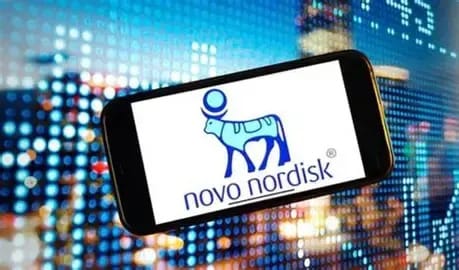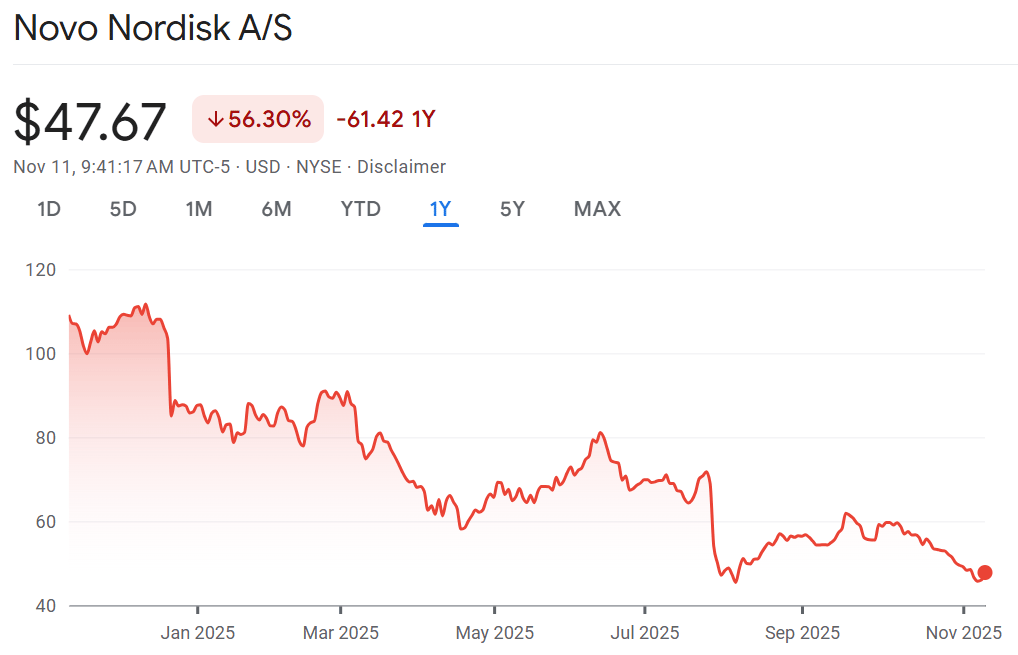- The Pragmatic Investor
- Posts
- Midweek Deep Dive: 💊 The Market Got Novo Nordisk Completely Wrong
Midweek Deep Dive: 💊 The Market Got Novo Nordisk Completely Wrong

🌞 Good Morning, Folks!
Everyone saw the headlines this week.
“Weight-loss drugs losing momentum.”
“GLP-1 stocks cooling off.”
“Peak Ozempic?”
And just like that, the market decided a three-year breakout trend had already run its course. A single pullback was treated like the end of a decade-long shift. But when you look past the noise, there’s a detail the headlines never touched — the demand didn’t drop. The stock did. And those are not the same thing.
There’s a difference between a story slowing down and a valuation resetting while the story continues forward. Most people can’t tell those apart. They panic when the price dips because they assume the fundamentals must have changed. But what if the only thing that changed was mood?
This week’s focus is one of those moments where the market narrative and reality have drifted apart. And that gap is where the edge is. We’re going to talk about Novo Nordisk — not the version in the headlines, but the one in the data, in the clinical outcomes, and in the adoption curve shaping global health behavior in real time.
I’m not going to tell you to ignore price. Price matters.
But the reason behind the price move matters more.
And right now, the market is reacting to impatience — not deterioration.
So let’s reset the lens.
The story isn’t ending.
The story is just at the part where most people look away — and disciplined investors step in.
🌐 From Around the Web
(Note: Although linked to a Motley Fool Meta piece due to the original request mismatch, the SoftBank/Nvidia sale story is confirmed via free-access news sources.)
SoftBank’s move to abandon its stake in the massive AI-chip leader is more than portfolio repositioning—it’s a glaring warning in high growth stocks. When one powerhouse exits a proven ride, the signal isn't just “reinvesting elsewhere”; it's “direction may be shifting.” Ignore this and you’re trading momentum blind.
Meta Platforms is seeing heavy institutional dumping post-earnings, with AI spending being cited as the key worry. While the rebound crowd calls any dip a buying opportunity, serious investors see this as a stress test of business model durability. If you ride the dip without tracking the deeper issue, you’re up for disappointment—not just correction.
Yahoo Finance’s outlook ties mortgage rates tightly to the 10-year Treasury: barring a deep recession, baseline expectations point to a higher-for-longer band, with cyclical dips if growth cools. For consumers and investors, the edge is in timing and structure — think points vs. par, 2-1 buydowns, and refi optionality if the curve breaks lower. The risk of waiting for “4% again” is opportunity cost if sticky 5–6% becomes the new normal.
TOGETHER WITH OUR PARTNER
Software sprawl? That’s SaaD.
Software was supposed to make work easier. Instead, most teams are buried under it.
That’s SaaD – Software as a Disservice. Dozens of disconnected tools waste time, duplicate work, and inflate costs.
Rippling changes the story. By unifying HR, IT, and Finance on one platform, Rippling eliminates silos and manual busywork.
HR? One update applies to payroll, benefits, app access, and device provisioning instantly.
Finance? Close the books 7x faster with synced data.
IT? Manage hundreds of devices with a single click.
Companies like Cursor, Clay, and Sierra have already left outdated ways of working behind – gaining clarity, speed, and control.
Don’t get SaaD. Get Rippling.
🔍 This Week’s Focus: The Market Still Doesn’t Get Novo Nordisk

The market still doesn’t understand what Novo Nordisk is actually building. It reacts to short-term headlines as if this is some temporary weight-loss trend, a hype cycle that’s already run its course. Meanwhile, the stock has pulled back to its lowest level in nearly three years, even though demand, medical validation, and global adoption are all dramatically higher than they were three years ago.
That disconnect matters.
Because the market isn’t reacting to business deterioration.
It’s reacting to impatience.
Investors wanted the revenue curve to go vertical faster than manufacturing capacity can scale. When that didn’t happen instantly, short-term money bailed — not because the story broke, but because their timeline did.
Here’s the truth:
You don’t call the end of a structural medical shift because manufacturing is catching up to demand.
If anything, that confirms the direction of the shift.
This is not a weight-loss trade.
This is the beginning of a multi-decade metabolic health realignment.
💊 The Earnings: What Actually Matters
Forget the noise — here are the real signals:
Metric | Result | Meaning |
|---|---|---|
Revenue Growth | ~20–30% YoY (driven by GLP-1) | Still accelerating → not late cycle |
Wegovy & Ozempic Sales | Strong YoY expansion | Demand remains overwhelming |
Supply Constraints | Still present | Demand > Capacity (the good kind of problem) |
Guidance | Raised | Management sees a long runway |
Gross Margins | Strong & steady | Pricing power intact |
There is zero evidence of slowing demand.
There is zero evidence of meaningful competitive displacement.
There is zero evidence of adoption fatigue.
What there is:
A temporary mismatch between how fast the world wants this drug and how fast plants can produce it.
That’s not bearish.
That’s timing friction.
And timing friction is an entry signal.
🧬 The Market Is Mispricing the Core Truth
Most investors are still treating obesity as a willpower problem.
That belief is obsolete.
GLP-1s don’t just cause weight loss. They re-wire appetite, reward loops, craving patterns, emotional eating circuitry, metabolic efficiency, and identity.
This is behavior change at the biological level.
People who experience this shift do not return to the old baseline.
Which means:
Retention is high
Revenue is recurring
Demand is self-reinforcing
This is not a product cycle.
This is a behavior shift that compounds over time.
And the market is not built to price behavior shifts correctly until years after they start.
That’s how long-term wealth is created here.
🏭 The Supply Problem Is Not a Demand Problem
Yes — supply is tight.
No — that does not threaten the thesis.
It defines it.
Novo Nordisk is:
Building new manufacturing plants
Scaling fill-finish production
Streamlining injector device manufacturing
Expanding API and distribution capacity globally
This is engineering + sequencing, not scrambling.
Novo and Eli Lilly aren’t fighting for customers.
They’re racing to scale production.
The company that scales faster wins the next 5–7 years of adoption.
Right now, Novo is positioned to do exactly that.
📉 So Why Did the Stock Pull Back?
Because the stock ran faster than the build-out timeline — not faster than demand.
This isn’t thesis damage.
This is positioning unwind:
Late money exited
Momentum traders rotated
Algo sentiment flipped
Price corrected
Fundamentals did not
The business today is stronger than when the stock was at its highs.
But the price has reverted to where it was before the world even understood GLP-1s.
That’s not just undervaluation.
That’s opportunity.
🎯 The Pragmatic Playbook

This is not a momentum trade.
This is controlled, rational position building while the valuation is wrong and the thesis is right.
How I Build the Position
Initial Entry (Now): Starter position while the stock sits near a 3-year price floor despite all-time-high demand signals.
Add Tranches: Add during -5% to -12% pullbacks — only if prescription demand stays strong.
Confirmation Add: Add again after Novo announces new manufacturing capacity online.
This makes volatility serve you — not shake you.
What I’m Watching (Signals > Emotion)
Driver | Bullish | Re-Evaluate |
|---|---|---|
Prescription Demand | Stable or increasing | Multi-quarter slowdown |
Supply Expansion | On schedule | Repeated multi-quarter delays |
Reimbursement Coverage | Expanding | Systematic coverage reversal |
Adherence | Users staying on therapy | Drop-off rates rising materially |
Price is noise.
These are signal.
We manage signal, not sentiment.
🧩 What This Means Going Forward
This is one of those rare setups where the price is telling one story and reality is telling another. The stock is sitting at a three-year low, while the underlying business is producing demand, adherence, pricing power, and category leadership at a scale the market still hasn’t processed. Supply catching up is not a risk — it’s the next unlock on the growth curve.
The question isn’t whether the market will eventually reprice this — it will.
The question is who is positioned before that happens, and who is still waiting for permission to believe what is already happening.
TOGETHER WITH OUR PARTNER
Prepare your pet for the unexpected
Accidents and illnesses happen when you least expect them. Pet insurance makes sure you’re prepared, with coverage for emergencies, chronic conditions, and wellness visits. Enroll today and give your pet the care they deserve.
🧠 What did you think of today's newsletter? |
🧠 Final Word
The stock is at a three-year low.
The business is at a multi-year high.
That gap won’t stay open forever.
Most investors only buy when the story is undeniable.
By then, the easy part of the upside is already priced in.
Our advantage isn’t prediction — it’s seeing the trend while the market is still debating it.
The thesis is clear:
Demand is structural. Supply is scaling. Retention is sticky.
So we don’t rush.
We build.
Deliberately. Patiently. Without noise.
Because when the market finally realizes what Novo Nordisk actually is,
we’ll already be in position.
Stay Sharp,
— AK

Disclaimer: The content on this blog is for educational and informational purposes only and is not intended as financial, investment, tax, or legal advice. Investing in the stock market involves risks, including the loss of principal. The views expressed here are solely those of the author and do not represent any company or organization. Readers should conduct their own research and due diligence before making any financial decisions. The author and publisher are not responsible for any losses or damages resulting from the use of this information.


Reply